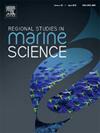Mats of green filamentous alga Cladophora in the hypersaline Bay Sivash: Distribution, structure, environment-forming role and resource potential
IF 2.1
4区 环境科学与生态学
Q3 ECOLOGY
引用次数: 0
Abstract
Marine coastal shallow lagoons are widespread worldwide; macroalgae and seagrasses often play a key role in their ecosystem functioning. The world's largest hypersaline lagoon Bay Sivash (the Sea of Azov) plays a vital role in maintaining the landscape connectivity and sustainability of the region. The green macroalga Cladophora sivashensis occupies hundreds of km−2 in the lagoon, forming the bottom and floating mats with wet biomass over 20 kg m−2. Data was obtained during expeditions to the lagoon. Sampling of mats was carried out at 15 stations on July 16–17, 2020, one site of these on May 27–29, 2022 (every four hours during the day), and June 21, 2022 (every four hours during three days). Measurements of environmental parameters (water temperature, photosynthetically active radiation, oxygen content, wind speed and direction, turbidity, etc.) were also done. Mats distribution is directly related to the direction and speed of the wind. Cladophora mats influenced the daily dynamics and the vertical distribution of most studied water parameters. In Bay Sivash, the average dry biomass of Cladophora mats was 2.25 kg (dry weight) m−2, and its total biomass in the lagoon can reach from 524 to 1573 thousand tons of dry weight. Obtained data allowed an assessment of the total biomass of Cladophora in the entire bay and quantify the influence of mats on the abiotic water parameters in the lagoon for the first time. The high Cladophora total biomass and productivity, a variety of valuable compounds in its biomass indicate that it can be considered as a potential resource in the lagoon for large-scale use in medicine, agriculture, and industry. may suggest such perspective areas as long-term monitoring of Cladophora development in lagoon and mats interactions with other species.
求助全文
约1分钟内获得全文
求助全文
来源期刊

Regional Studies in Marine Science
Agricultural and Biological Sciences-Ecology, Evolution, Behavior and Systematics
CiteScore
3.90
自引率
4.80%
发文量
336
审稿时长
69 days
期刊介绍:
REGIONAL STUDIES IN MARINE SCIENCE will publish scientifically sound papers on regional aspects of maritime and marine resources in estuaries, coastal zones, continental shelf, the seas and oceans.
 求助内容:
求助内容: 应助结果提醒方式:
应助结果提醒方式:


